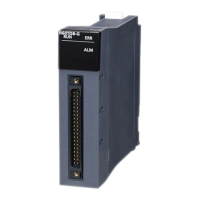574
7 APPLICATION INSTRUCTIONS
7.4 Structure Creation Instructions
■Applicable devices
*1 Any value other than F can be used.
• When the EFCALL(P) instruction is executed, these instructions perform non-execution processing
*2
of the subroutine
program of the pointer specified by (P). The EFCALL(P) instructions can also call the subroutine program using the local
pointer of another program file.
*2 Non-execution processing is the same as the processing performed by each coil instruction with the condition contact set to off.
• The operation results of individual coil instructions after the end of non-execution processing are as follows regardless of
on/off of the condition contact.
Operand Bit Word Double word Indirect
specification
Constant Others
(P)
X, Y, M, L,
SM, F, B, SB,
FX, FY
J\ T, ST, C, D, W,
SD, SW, FD, R,
ZR, RD
U\G, J\,
U3E\(H)G
Z LT, LST,
LC
LZ K, H E $
(File name)
(P)
(s1)(s5)
*1
(1) Non-execution processing is performed when the command of the
EFCALL(P) instruction changes from on to off.
Device used for operation Operation result (device status)
High-speed timer, low-speed timer Set to 0
High-speed retentive timer, low-speed retentive timer, counter Maintains the current status.
Device in OUT instruction Forcibly turned off.
Device in the SET, RST, SFT(P), or basic/application instruction Maintains the current status.
PLS or pulse instruction (P) Performs the same processing as when the condition contact
is off.
END
EFCALL ʺABCʺ (P)
(P)
RET
(1)
[File name: MAIN]
Main routine program
[File name: ABC]
Subroutine program

